12 race cars on 2022’s Monterey auction grid
In just a few days, Monterey Car Week will overrun the quiet California ocean town with the world’s rarest and most seductive vehicles. They’ll quite literally be everywhere: at the myriad shows, entered in the concours, or conspicuously parked between rental cars in hotel parking lots. Many will also be up for grabs at various auctions around town.
The crop of race cars for sale this year is particularly mouth-watering, from a Ferrari campaigned by Carroll Shelby to a Dupont-liveried Monte Carlo driven by Jeff Gordon. Let’s take a look at the highlights.
1955 Ferrari 410 Sport Spider by Scaglietti
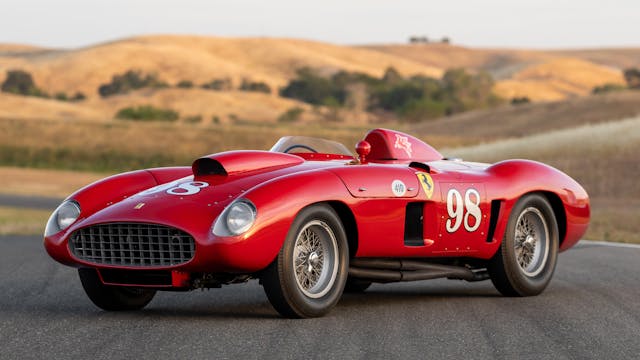
Estimate: $25M–$30M
Hold onto your trousers, Enzo: This Ferrari is poised to make a big splash next week. This Scaglietti-bodied Ferrari (chassis number 0598CM) is just one of two built in this spec and possess a matching-numbers chassis, body, and engine. Featuring a 4.9-liter V-12, this big-displacement Ferrari was raced by many of the world’s greatest drivers from the mid-century, including Juan Manuel Fangio, Phill Hill, Masten Gregory, and Jim Rathman. Oh, and some Texan named Carroll Shelby.
In fact, Shelby won more driving this exact car than any other car he drove in his career, amassing eight wins and ten podiums for So-Cal Ferrari privateer John Edgar. The chicken farmer’s inscription on the fuel tank reads: “Mr. Ferrari told me that this was the best Ferrari he ever built.” We’ll soon know to what degree bidders share the same sentiment.
1963 Jaguar E-Type Lightweight

Estimate: $7M–$8.5M
Developed in opposition to the Ferrari GTO, which took sports-car racing by storm in the early ’60s, the Jaguar E-Type Lightweight arrived for Briggs Cunningham and Kjell Qvale, respectively, ahead of the 1963 12 Hours of Sebring. This car was not far behind, delivered to Cunningham in June 1963.
Chassis number S850664 was just the seventh Lightweight built, and the second of the three sold to Cunningham. Equipped with a more reliable four-speed, the Jaguar arrived at Le Mans in 1963 with a #14 on the door and Walt Hansgen and Augie Pabst sharing driving duties. Ironically, the gearbox failed an hour into the race. The ZF five-speed was fitted after returning home from the French contest.
In the years since, the Jaguar has traded hands multiple times and has been maintained to resemble the car as it appeared roaring down the Mulsanne in 1963, sporting an aluminum 3.8-liter inline-six and the classic American livery with Cunningham stripes. “With a string of famous collectors (sometimes owned more than once), this lightweight E-Type would be an excellent addition to any collection,” says Hagerty’s manager of Valuation analytics John Wiley.
2007 Porsche RS Spyder Evo

Estimate $6M–$8M
Some 35 years after Porsche and Penske dominated Can-Am racing with variations on the turbocharged 917, the two groups came together once again to campaign the RS Spyder in global endurance racing. This car, one of only 17 RS Spyder prototypes built between 2005 and 2008, captured two outright wins, four class wins, and ultimately helped The Captain earn back-to-back American Le Mans Series championships.
Underneath the yellow-wrapped carbon fiber beats a 3.4-liter V-8 producing over 500 horsepower. “The thrill of shifting this engine at 10,000 rpm and taking turns flat-out in fifth and sixth gear, with complete control, is like none I’ve ever experienced,” says the consignor. Even over a decade since its dominance, this modern icon is still a head-turner, and has been celebrated as such at vintage exhibits like Porsche’s Rennsport Reunion. “This is the last prototype racing car a collector will be able to buy from Porsche, and you don’t need a team of people to run it.”
1998 Ferrari F300
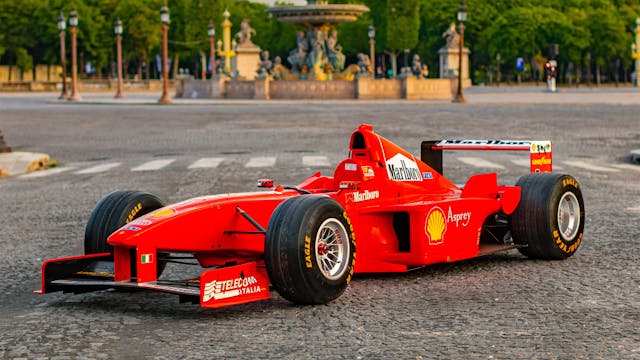
Estimate $6M–$8M
In the winter of 1998, Ferrari invited over 800 journalists to Maranello to preview its newest Formula 1 racer, the F300. The Rory Byrne–designed car utilized a novel 3.0-liter, 80-degree V-10, which spun to some 17,500 rpm and produced 800 horsepower.
The marriage between the new car and F1 phenom Michael Schumacher was electric. Despite losing driver’s championship, the 1998 season represents a large step towards Ferrari’s dominance later in the Aughts. In this specific car (chassis number 187), Schumacher went four-for-four in the win column, making it the most successful Ferrari Formula 1 chassis ever. In 1999, it was acquired from Scuderia Ferrari by its current owner, who has since preserved the car in its as-raced condition: still undefeated.
1957 Ferrari 250 GT LWB Berlinetta Scaglietti “Tour de France”

Estimate: $6M–$7M
Designed by Pinin Farina and built by Scaglietti, this aluminum-bodied competition Berlinetta turned gentleman racers into forces to be reckoned with. The 3.0-liter V-12 shoved the lightweight Berlinetta to many victories, including a series of “Tour de France” races (1956–1959). That impressive string of wins earned the car its moniker.
This, the only car on the list without a racing livery, nonetheless has a very colorful past. Pierre Noblet purchased a brand new Berlinetta (chassis 0619 GT) for his racing escapades in 1957. Following just one season, Noblet was back in Maranello for a newer “Tour de France,” a three louver Series II (chassis 0805 GT). Likely for tax purposes, Noblet requested that he retain his original chassis number for the Series II. Ferrari obliged, and 0805GT was now 0619GT.
In 1960, Noblet ditched his Series II for a 250 GT SWB Berlinetta Competizione. The discarded Ferrari traded hands several times before reportedly rearranging the brick wall of a Peugeot factory at the hands of a young driver. The damage sustained didn’t spell the end of the line for this Ferrari, though: By the early ’70s renowned Ferrari restorer Wayne Sparling took ownership of the TdF with the aim of returning it to its prior glory. By 2003 the car made its post-restoration debut.
In 2016, following Sparling’s passing and the sale of this “Tour de France” Ferrari, the car’s original body panels were located on his property. Under the stewardship of the two most recent owners, the original panels were fitted to the car in a no-expense-spared restoration in Italy. Now, 65 years after this Berlinetta was first delivered to Noblet, it is Ferrari “Red Book” Classiche certified.
1969 Porsche 908/02
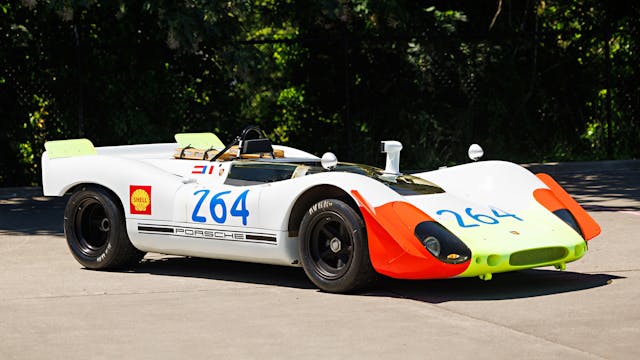
Estimate $4M–$5M
After the 2.2-liter Porsche 907 but before the burly 917, Stuttgart’s finest fielded the 908 for sports car racing. Even though Ferdinand Piëch and engineer Helmut Bott originally conceived the car as a coupe, Group 6 specs in 1969 forced the team to reimagine the Porsche as a Spyder. 220 pounds lighter than the original design, the 908/02 weighed in at just over 1300 pounds dripping wet. A 350-hp, 3.0-liter flat-eight pushed the bantamweight 908/02 to around 180 mph.
This Spyder (908/02-010) was campaigned by Porsche at Brands Hatch, the Targa Florio, and the Nürburgring in 1969. Even more iconic are the drivers who sat behind the wheel, including Vic Elford, Richard Atwood, and Pedro Rodriguez. After its stint as a works car, the 908 participated in four 24 Hours of Le Mans under privateer banners.
Unlike many 908s with gaps in their histories, this particular 908 has extensive documentation dating back to its first days on the track.
1965 Shelby Cobra 427 Competition

Estimate $2.4M–$3.3M
Only one of 23, this rare factory-built Competition 427 Cobra (CSX3006) raced throughout Europe in 1966. The Cobra’s most notable race came at the Ilford Films 500 at Brands Hatch, where it emerged victorious, securing the first—and only—significant European triumph for a production Shelby 427 Cobra, with David Piper and Bob Bondurant sharing driver duties. After trading hands several times, Legendary Motorcar Company restored the Cobra back to its original specifications, including the metallic blue paint, FIA Halibrand wheels, and a left-hand-drive configuration.
1974 Alfa Romeo Tipo 33 TT 12
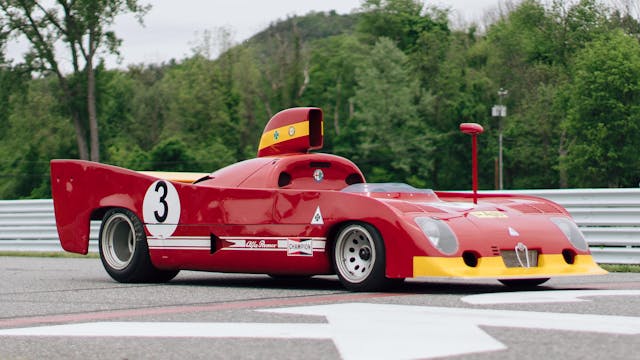
Estimate $1.7M–$2.2M
Armed with an 11,000 rpm, 3.0-liter flat-12 screamer, this Tipo 33 TT 12 (chassis 007) recorded three runner-up finishes in 1974. The 500-hp prototype racer has had only three owners since its competition debut, and appears to be unrestored. “It is one of the most original Tipo 33s and an excellent value for a sports racing car of this era,” says Wiley.
1994 Nissan Skyline GT-R “JGTCC-GT1” by Hasemi Motorsport
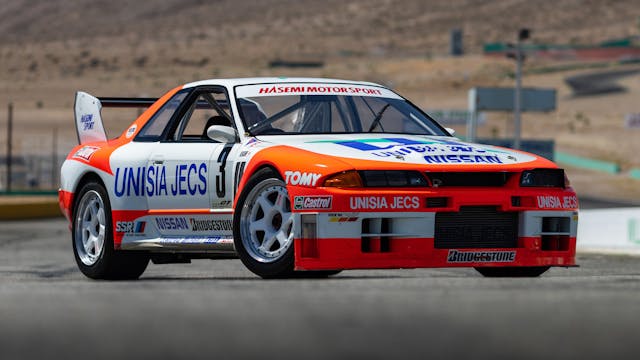
Estimate $500K–$550K
“With road-going Skylines so popular in the market at present, their reputation as successful race cars is often overlooked,” says Wiley. This is shocking considering how dominant the cars were through the early ’90s.
In fact, “dominant” may severely understate how much success Nissan’s third-gen Skyline GT-R found in Japanese touring car competition. The car went undefeated for four straight seasons. No other manufacturer found victory lane from 1990 to 1993. The R32 burnished its reputation abroad as well, experiencing success in Australian and European series.
This super coupe was built by Hasemi Motorsport in partnership with NISMO for the 1994 Japan Grand Touring Car Championship and driven by “Mr. Skyline” Masahiro Hasemi to second place in the season standings that year. Hasemi piloted this Skyline to victory in the inaugural 24 Hours of Tokachi endurance race, besting the rest of the pack by ten laps.
After its final race in 1995, the R32 was retired by Hasemi and showcased at their team offices. A year later, the current Tokyo-based consignor acquired the car from the race team.
1962 Kurtis-Kraft Aguilla

Estimate $450K–$500K
Frank Kurtis and his Kurtis-Kraft company were synonymous with open-wheel performance throughout the mid-20th century. Their midgets, sprint cars, and Indy roadsters were as fast as they were beautiful. The firm solidified its reputation in the 1950s at the hallowed Indianapolis Motor Speedway in the ’50s, taking home no less than five Indy 500 victories.
As Kurtis approached retirement in 1962, Houston gentleman racer Herb Stetler commissioned an open-wheel car for SCCA competition. Kurtis suggested his company could produce a car that would be able to compete in Formula 366 and sports car racing by building removable bodywork. Underneath those salacious curves, Stetler and mechanic Dale Burt bolted in a 327-cubic-inch small block Chevy married to a four-speed transmission. Despite the parts pedigree, the Aguilla was unable to finish any of the dozen or so races in which the car was entered.
Earlier this year, the car was stripped bare and refinished in the original livery. One of the last Kurtis-designed racers, the Aguilla may be one of the most beautiful.
1972 AAR Gurney Eagle Indy Car
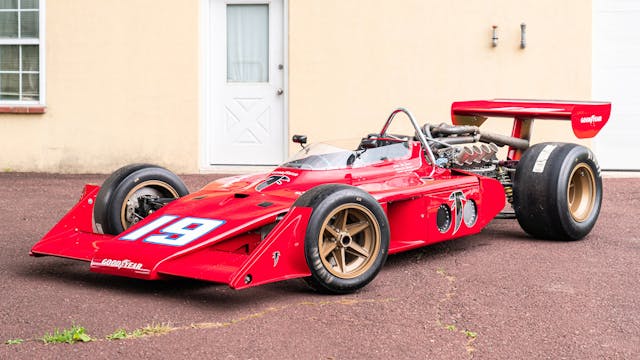
Estimate $250K–350K
No name carries more cachet across all racing disciplines than Dan Gurney. Regardless of the series or venue, the man built, drove, and owned winning race cars. The 1972 Eagle Indy Car—true to Gurney form—was one of the most successful chassis in the sport’s history and was the first car to exceed a 200 mile-per-hour lap average. Chassis 72-11 is one of approximately thirty ’72 Eagles built. It was sold new to veteran Indy team owner Lindsey Hopkins and driven by Mel Kenyon over three seasons, notably finishing fourth in the 1973 Indy 500.
According to Wiley, the trouble with collecting Gurney cars is that they rarely change hands. This 1972 Gurney Eagle Indy Car represents an excellent opportunity to take one home.
2004 Chevrolet Monte Carlo NASCAR “Jeff Gordon”
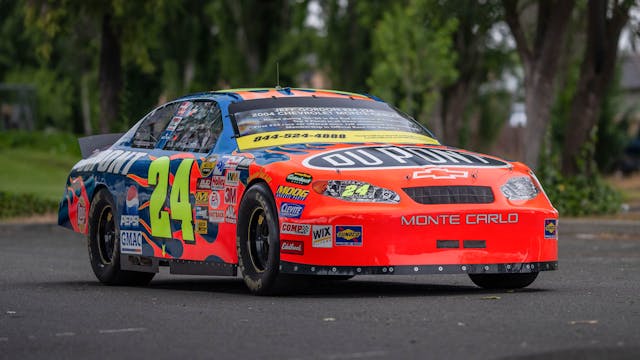
Estimate $150K–$200K
In 2001, after Jeff Gordon won his fourth championship in seven years, fans thought it was only a matter of time until “Wonder Boy” would eclipse Earnhardt and Petty’s high-water mark of seven titles. Sadly, the “Drive for Five” never happened for Gordon.
Still, the Aughts presented some highlights for Gordon and his #24 team. In fact, during this car’s tenure, Gordon won 11 races over the course of three years. While he never pulled into victory lane with this piece, car number 24-224 is representation of three very successful seasons. It also comes dressed in Dupont’s flame scheme, an equally-popular follow-up to the rainbow livery the team ran in the ’90s. Underneath the flames, an equally loud 830-horsepower Hendrick SB2 V-8 awaits its new owner’s heavy right foot.
Are you planning to attend Monterey Car Week? Keep up to date on the latest news and events by subscribing to our special edition newsletter or text Pebble22 to 227588 (CAR LUV) for real-time event updates straight to your phone.
*Hagerty has entered into a definitive agreement to acquire Broad Arrow Group. You can read more about it here.


